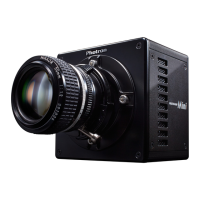3.19. Using External Synchronization Signals
An external synchronization mode to synchronize to an external signal is provided on the system. By
using an external synchronization signal, recording can be conducted using multiple cameras to
synchronize the timing of the shots or to also synchronize the shots with external measuring devices
and lighting. The procedure and precautions for using the external synchronization signal are
explained below.
3.19.1. Inputting an External Synchronization Signal
An external synchronization signal can be input with the system. See the chart below for external
synchronization input settings.
Signal (Input Signal Conditions)
OFF
Sets external synchronization off, operates
(none)
ON CAM POS
Synchronizes to a positive polarity signal
from Photron products.
FET Input 0V - +12V (H level
+2.5V to +12V), Positive
ON CAM NEG
Synchronizes to a negative polarity signal
from Photron products.
FET Input 0V - +12V (H level
+2.5V to +12V), Negative
ON OTHERS POS
Synchronizes to a positive polarity signal
from an external device
(including other Photron products).
FET Input 0V - +12V (H level
+2.5V to +12V), Positive
ON OTHERS NEG
Synchronizes to a negative polarity signal
from an external device (including other
FET Input 0V - +12V (H level
+2.5V to +12V), Negative
3.19.2. Outputting an External Synchronization Signal
The system can externally output a synchronization signal. Output of the external synchronization
signal is performed from the GENERAL OUT connector explained in section “2.2.7. See the chart
below for external synchronization output settings.
SYNC POS
Outputs a positive polarity
vertical synchronization signal.
CMOS (74ACT541 buffer)
output, positive polarity
Approx. 315nsec
SYNC NEG
Outputs a negative polarity
vertical synchronization signal.
CMOS (74ACT541 buffer)
output, negative polarity
Approx. 330nsec
55 FASTCAM SA-Z Hardware Manual

